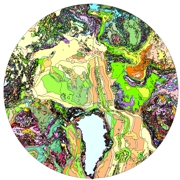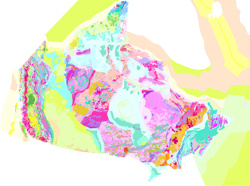earth sciences
Type of resources
Available actions
Topics
Keywords
Contact for the resource
Provided by
Years
Formats
Representation types
Update frequencies
status
Service types
Scale
Resolution
-
GEO - Geological and geophysical (geoscientificInformation)The earth sciences. For example, resources describing geophysical features and processes; minerals; the composition, structure, and origin of the earths rocks; earthquakes; volcanic activity; landslides; gravity information; soils; permafrost; hydrogeology; and erosion
-

As part of the International Polar Year (IPY) 2007'08 and 2008'09 activities, and related objectives of the Commission for the Geological Map of the World (CGMW), nations of the circumpolar Arctic have co-operated to produce a new bedrock geology map and related digital map database at a scale of 1:5 000 000. The map, released in north polar stereographic projection using the World Geodetic System (WGS) 84 datum, includes complete geological and physiographic coverage of all onshore and offshore bedrock areas north of latitude 60° north.
-
The digital Polling Division boundary files provided are made available from Elections Canada. The data contains the digital federal electoral districts under the Representation Order of 2015.
-

The Geological Survey of Canada (Atlantic and Pacific) has collected marine survey field records on marine expeditions for over 50 years. This release makes available the results of an ongoing effort to scan and convert our inventory of analog marine survey field records (seismic, sidescan and sounder) to digital format. These records were scanned at 300 dpi and converted into JPEG2000 format. Typically, each of these files was between 1 to 2 gbyte in size before compression and compressed by a factor of 10:1. Empirical tests with a number of data sets suggest that there is minimal visual distortion of the scanned data at this level of compression. In this KML file, scanned data are available in a reduced-scale thumbnail format and a compressed full-resolution JPEG2000 format.
-

Prospectivity model highlights areas of Canada with the greatest potential for Mississippi Valley-type zinc deposits. The preferred prospectivity model is based on public geological, geochemical, and geophysical datasets that were spatially indexed using the H3 discrete global grid system. Each H3 cell is associated with a prospectivity value, or class probability, calculated from the best-performing gradient boosting machines model. Model results are filtered to include the top 20% of prospectivity values for visualization purposes.
-

Prospectivity model highlights areas of Canada with the greatest potential for clastic-dominated zinc deposits. The preferred prospectivity model is based on public geological, geochemical, and geophysical datasets that were spatially indexed using the H3 discrete global grid system. Each H3 cell is associated with a prospectivity value, or class probability, calculated from the best-performing gradient boosting machines model. Model results are filtered to include the top 20% of prospectivity values for visualization purposes.
-

Prospectivity model highlights areas of Canada with the greatest potential for magmatic nickel deposits. The preferred prospectivity model is based on public geological, geochemical, and geophysical datasets that were spatially indexed using the H3 discrete global grid system. Each H3 cell is associated with a prospectivity value, or class probability, calculated from the best-performing gradient boosting machines model. Model results are filtered to include the top 20% of prospectivity values for visualization purposes.
-

The map displays bedrock formations at or near the surface of the land, on the sea floor above the continental crust that forms the Canadian landmass, and oceanic crust surrounding the landmass. The bedrock units are grouped and coloured according to geological age and composition. The colours of offshore units and oceanic crust are paler and more generalized than those on land, although the constituent units offshore are still easily discernible from their dashed boundaries. This colour design, coupled with the use of a white buffer zone at the coast allows the coastline of Canada to be readily distinguished and still show the grand geological architecture of the Canadian landmass. The map also shows major faults that have disrupted the Earth's crust, onshore and offshore, and a variety of special geological features such as kimberlite pipes, which locally contain diamonds, impact structures suspected to have been caused by meteorites, and extinct and active spreading centres in the surrounding oceans.
-

A predictive model for Canadian carbonatite-hosted REE ± Nb deposits is presented herein. This model was developed by integrating diverse data layers derived from geophysical, geochronological, and geological sources. These layers represent the key components of carbonatite-hosted REE ± Nb mineral systems, including the source, transport mechanisms, geological traps, and preservation processes. Deep learning algorithms were employed to integrate these layers into a comprehensive predictive framework. Here is a link to the publication that describes this product: https://link.springer.com/article/10.1007/s11053-024-10369-7
-

The Canada Geological Map Compilation (CGMC) is a database of previously published bedrock geological maps sourced from provincial, territorial, and other geological survey organizations. The geoscientific information included within these source geological maps wasstandardized, translated to English, and combined to provide complete coverage of Canada and support a range of down-stream machine learning applications. Detailed lithological, mineralogical, metamorphic, lithostratigraphic, and lithodemic information was not previously available as onenational-scale product. The source map data was also enhanced by correcting geometry errors and through the application of a new hierarchical generalized lithology classification scheme to subdivide the original rocks types into 35 classes. Each generalized lithology is associated with asemi-quantitative measure of classification uncertainty. Lithostratigraphic and lithodemic names included within the source maps were matched with the Lexicon of Canadian Geological Names (Weblex) wherever possible and natural language processing was used to transform all of the available text-basedinformation into word tokens. Overlapping map polygons and boundary artifacts across political boundaries were not addressed as part of this study. As a result, the CGMC is a patchwork of overlapping bedrock geological maps with varying scale (1:30,000-1:5,000,000), publication year (1996-2023), andreliability. Preferred geological and geochronological maps of Canada are presented as geospatial rasters based on the best available geoscientific information extracted from these overlapping polygons for each map pixel. New higher resolution geological maps will be added over time to fill datagaps and to update geoscientific information for future applications of the CGMC.
 Arctic SDI catalogue
Arctic SDI catalogue